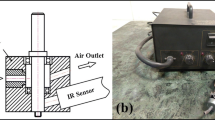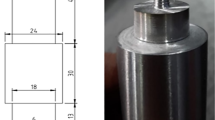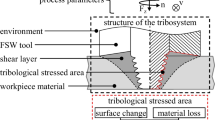Abstract
Friction stir welding (FSW) is a solid-state welding technique providing a number of unique advantages such as the weldability of various similar and dissimilar material combinations, the absence of process gases and filler materials, and high mechanical joint strengths. The operation principle is based on a rotating tool consisting of shoulder and probe. Due to friction-induced heat input, generated by the tool, the work pieces can be firmly bonded by dynamical deformation across the interface. However, the general application for this method is restricted by properties such as accessibility, high demands on the clamping technique, and in particular comparatively high process forces in the range of several kN. Process forces arise during the interaction between welding tool and the joining material and are decisively influenced by the dimensioning of shoulder and probe. In this study, a decrease of the process force could be achieved by tool scaling, which means the stepwise reduction of the shoulder and probe diameter. Furthermore, a method is developed to adapt the welding conditions for scaled FSW-tools. The study was carried out with a robotised FSW setup on 2-mm thick EN AW 6060 T66 sheets. The results show a decrease in process force of up to 60% and a spindle torque reduction of up to 80%.













Similar content being viewed by others
References
Rührreibschweißen – Aluminium – Teil 1: Begriffe (ISO 25239-1:2011); Dreisprachige Fassung EN ISO 25239-1:2011)
Mishra RS, Kumar N (2014) Friction Stir Welding and Processing- Science and Engineering. Springer, Cham, ISBN 978-3-319-07042-1, pp 1–338
Kumar N, Mishra RS, Baumann JA (2014) Residual Stresses in Friction Stir Welding, Elsevier Butterworth-Heinemann,first edition, 1-60
Jannet S, Mathews PK, Raja R (2014) Comparative investigation of friction stir welding and fusion welding of 6061 T6 – 5083 O aluminum alloy based on mechanical properties and microstructure. B Pol Acad Sci-Chem 62:791–795
Hattingh DG, Blignault C, van Niekerk TI, James MN (2008) Characterization of the influences of FSW tool geometry on welding forces and weld tensile strength using an instrumented tool. 203:46–57
Kumar R, Singh K, Pandey S (2012) Process forces and heat input as function of process parameters in AA5083 friction stir welds. Trans Nonferrous Metals Soc China 22:288–298
Abegunde OO, Akinlabi ET, Madyira DM (2016) Force feedback analysis: friction stir welding of aluminium metal matrix composite. Proceedings of the World Congress on Engineering 2. ISBN: 978–988–14048-0-0
Chen C, Kovacevic R (2004) Thermomechanical modelling and force analysis of friction stir welding by the finite element method, Proceedings of the Institution of Mechanical Engineers Part C. J Mech Eng Sci 218:509–519
Langari J, Kolahan F, Aliakbari K (2016) Effect of tool speed on axial force, mechanical properties and weld morphology of friction stir welded joints of A7075-T651. Tansactions C: Aspects 29:403–410
Papahn H, Bahemmat P, Haghpanahi M, Aminaie IP (2015) Effect of friction stir welding tool on temperature, applied forces and weld quality. IET Sci Meas Technol 9:475–484
Sorensen CD, Stahl AL (2007) Experimental Measurements of Load Distributions on Friction Stir Weld Pin Tools. Metall Mater Trans B 38 B:451–459
E-Rabby MR, Tang W, Reynolds AP (2014) Effect of tool pin thread forms on friction stir weldability of different aluminum alloys. Procedia Eng 90:637–642
Metha M, Arora A, De A, DebRoy T (2011) Tool Geometry for Friction Stir Welding—Optimum Shoulder Diameter. Metallurgical and Materials Transactions A 2716–2722
Arora A, De A, DebRoy T (2011) Toward optimum friction stir welding tool shoulder diameter. Scr Mater 64:9–12
Arora, Metha M, De A, DebRoy T (2012) Load bearing capacity of tool pin during friction stir welding. Int J Adv Manuf Technol 61:911–920
Roth A (2016) Modellierung des Rührreibschweißens unter besonderer Berücksichtigung der Spalttoleranz: Dissertation Technische Universität München. Herbert Utz Verlag München: UTZ. ISBN: 978–3–8316-4639-5
Blignault C, Hattingh DG, Kruger G, van Niekerk TI, James MN (2008) Friction stir weld process evaluation by multi-axial transducer. Measurement London 41:32–43
DIN EN ISO 755-2:2016–10, Aluminium und Aluminiumlegierungen – Stranggepresste Stangen, Rohre und Profile – Teil 2: Mechanische Eigenschaften; Deutsche Fassung EN 755–2:2016, 1–52 (2016)
DIN EN 573–3:2013–12, Aluminium und Aluminiumlegierungen – Chemische Zusammensetzung und Form von Halbzeug – Teil 3: Chemische Zusammensetzung und Erzeugnisformen; Deutsche Fassung EN 573–3:2013, 1–30 (2013)
DIN EN ISO 4136, Zerstörende Prüfung von Schweißverbindungen an metallischen Werkstoffen – Querzugversuch (ISO 4136:2012); Deutsche Fassung EN ISO 4136:2012
Völlner G (2010) Rührreibschweißen mit Schwerlast-Industrierobotern: Dissertation Technische Universität München. Herbert Utz Verlag München: Utz, 1–196. ISBN 978-3-8316-0955-0
Grätzel M, Weigl M, Regensburg A, Schürer R, Hasieber M, Bergmann J-P (2017) Process force reduction during friction stir welding of EN AW 6060 T66 with scaled tool diameters, conference proceedings of 5th International Congress and Exhibition on Aluminium Heat Exchanger Technologies for HVAC&R, 16/17 May, 2017 Düsseldorf/Germany, DVS Media GmbH, 1-60
Acknowledgements
The IGF Project No. 18.843 B of the research association, Schweißen und verwandte Verfahren e.V. “of the DVS, Aachener Straße 172, 40223 Düsseldorf, was on the basis of a resolution of the German Bundestag, promoted by the Federal Ministry for Economic Affairs and Energy via AiF within the framework of the program for the promotion of joint industrial research and development (IGF). The authors thank all the industrial participants in particular Dr. Weigl and Dr. Meyer for the funding and the support.
Author information
Authors and Affiliations
Corresponding author
Additional information
Recommended for publication by Commission III - Resistance Welding, Solid State Welding, and Allied Joining Process
Rights and permissions
About this article
Cite this article
Grätzel, M., Regensburg, A., Hasieber, M. et al. Scaling effects during friction stir welding of aluminum alloys with reduced tool aspect ratios. Weld World 63, 337–347 (2019). https://doi.org/10.1007/s40194-018-0666-7
Received:
Accepted:
Published:
Issue Date:
DOI: https://doi.org/10.1007/s40194-018-0666-7




